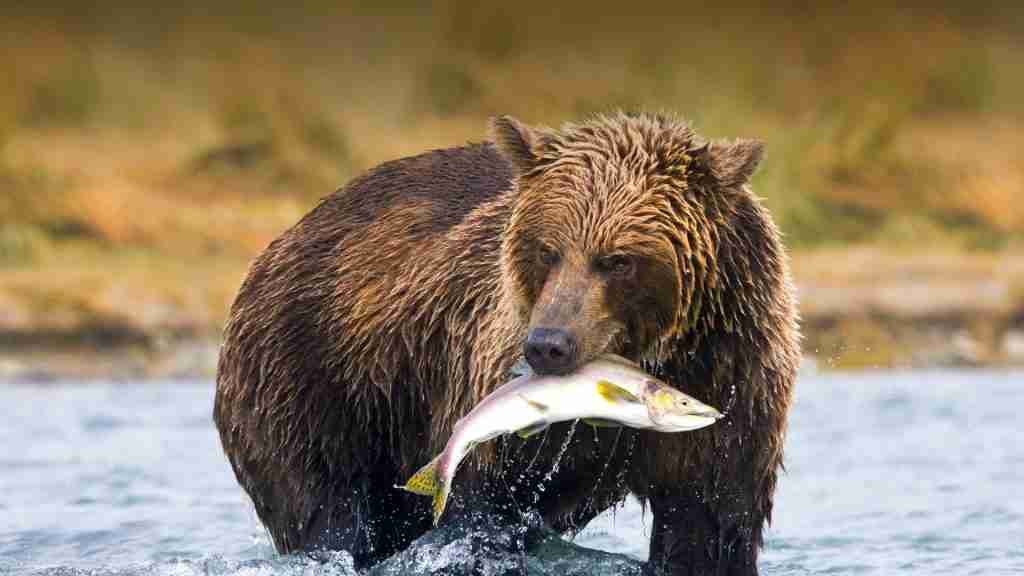Maybe you’ve heard about Grizzly bears or even seen them in the zoo. And because of their large body, you probably think they eat a lot.
That’s right! But here’s a good question – are grizzlies considered omnivores or carnivores?
Answer – Grizzly bears are omnivorous animals. This means they eat both plants and animals.
Although there’s a popular assumption that grizzly bears eat only meat, sadly, they do not! In fact, they eat fish, vegetables, elk meat, and deer meat evenly.
Interestingly before, grizzly bears were fully carnivorous creatures but now their digestive systems have evolved.
It has developed into the same digestive structure as omnivorous animals.
Now that you’ve found out that Grizzly bears are omnivores, wouldn’t you like to know what type of food they eat?
Read on to find out!
Types Of Food Grizzly Bear Eats

A grizzly bear’s essential diet contains both vegetarian and non-vegetarian foods.
It feeds on local plants, meat, and fish. Hence, the differences in the types living in different areas.
Grizzly bears that are not mature enough do not go in search of food until they are old enough to protect themselves.
| PLANTS | ANIMALS | FRUITS & VEGGIES |
| Grass | Fish | Pine seeds |
| Roots & Tubers | Dear & Elk | Acorns |
| Flowers | Caribou | Apples & Berries |
| Sheep & Mountain Goats |
Actual food may vary based on region and availability
Plants:
Here are the plants that grizzlies normally eat:
Grass
Grizzly bears love eating grasses, especially Sedge grass stalks which are stiff, wide, and spiky.
It contains about 25% protein. This is why the grizzly bear feeds on it more than other grasses.
In spring, grizzly bears eat up to 70% of sedge grass to restore the protein they lost during hibernation.
Roots and Tubers
Grizzly bears have straight and long claws, and even broad shoulder strength.
They use it in digging up food stuff like roots, tubers, bulbs, and corms from the soil.
They eat them because they are rich in carbohydrates which gives them strength for their daily activities.
Flowers
Surprisingly, these creatures enjoy eating flowers like dandelions, clovers, and aspen.
These flowers are high in protein and they eat it immediately after leaf burst or flowering.
When they grow, they get lignin & cellulose then become a bit tough to digest.
Meat:
Here is the type of meat that grizzlies normally eat:
Fish
Grizzly bears are great swimmers. Their ability to swim helps them to hunt fish, especially salmon.
Salmon fish is an essential component of the grizzly bear’s diet in summer.
It is rich in fatty acid which the grizzly bear requires to sustain itself during hibernation in winter.
Deer and Elk
Grizzly bears bank on their powerful sense of smell, strength, speed, and sharp teeth to hunt.
They hunt other mammals as big as grown-up deer and elks but usually succeed in killing young, weak, and wounded ones.
Caribou
Meat and Fish are important sources of fat and protein, and a lot of non-coastal bears depend on them.
Bears like grizzly are very significant predators of newborn caribou as another source of protein.
Sheep and Mountain goats
Grizzly bears commonly kill and eat them when they find them down alpine slopes or subalpine parklands (mountainous areas) during spring and fall.
These goats stay in these mountain areas to avoid them. However, mountain goats get unfortunate each time they climb down the mountain to graze.
Grizzlies often kill the young ones because of how vulnerable and defenseless they are.
And some other times, they kill adult ones. But these adults have chances of defending themselves with their sharp and pointed horns.
Just like they did in British Columbia’s Yoho National Park. A mountain goat killed a hunting grizzly bear.
READ OUR FULL GUIDE ON: DO GRIZZLY BEARS EAT MEAT?
Fruits & Vegetables:
Here is the type of meat that grizzlies normally eat:
Pine seeds
Grizzly bears make pine seeds their favorite food, particularly in spring (March to May) before they hibernate.
And In the fall (September to November) when they are out of hibernation.
Acorns/Oaks
Acorns or oaks are sweet meals in the eastern woodlands. Grizzly bears eat them in the fall after hibernation to replenish protein.
Apples and Berries
Throughout summer, a lot of berries and apples are available.
Bears are fond of apples and grizzly bears are inclusive.
An adult Grizzly bear can eat up to 200,000 raspberries, strawberries, blueberries, apples, and other soft fruits in a day.
How Much Food Can Grizzly Bears Eat Per Day?
Grizzly bears spend almost all their time eating up to 30 lbs of nutritious food.
They go in search of grasses, nuts, roots, fruits, insects, rodents, salmon, sheep, elk, deer, bison, etc.
The animal eats this much to store up additional fats which it will use to survive winter (hibernation period).
This means that grizzly bears take a long rest throughout winter without wanting to eat.
The Grizzly Bear Diet
Grizzly bears feed on diets that are 90% plants and vegetables. Yet they are very flexible in their dieting.
They eat everything from marine mammals, to salmon, insects, fruits, and roots.
How they eat depends on the period of the year and the food available in that particular area.
For example
After winter, when grizzly bears fall out of their den where they hibernated, varieties of food might not be available.
Possibly, the melting of ice has carried away certain leaves, now flower buds begin to spread.
This is usually bad news for the grizzly bear but it will always find a way to eat.
It can settle for dead bodies of animals and dried fishes that are left.
Do Grizzly Bears Have Different Diets In Different Seasons?
Yes, grizzly bears have different diets in different seasons.
The kind of food they eat changes with the time of the year. Let’s discuss in detail below:
Winter
Grizzly bears go through hibernation in the early months of winter.
And this is the actual reason for the differences in their dieting per season.
In winter they don’t need to eat or drink.
The extra fat they gained during summer and fall helps them to sustain for these 5-7 months of winter.
Spring
- Winter animals
- Grasses
- Clover
- Sedges
- Ants
- Horsetail
- Spring beauty
Note: They kill these winter animals close to their den and the adult female grizzlies eat them with their babies.
Summer
- Biscuit roots
- Fern-leaved lovage
- Thistle
- Mushrooms
- Truffles
- Whitebark pine
- Yampa
- Salmon
- Elk
- Deer
Fall
- Roots
- Tubers
- Berries
- Whitebark Pine seeds
- Insects
- Nuts
- Cutworm moths
Note:
When the month of fall comes, grizzly bears start to pack these foods into their dens for themselves and their cubs.
Final Thoughts
To recap, grizzly bears are omnivorous animals. This means they can both eat plants and animals.
They eat plants (Grass, Roots, and Tuber), fruits & vegetables (Pine seeds, Acorns Apples, and Berries), and meats (elk, deer, sheep, etc).
Among all these foods, they take their favorite to be plants, fruits, and vegetables.
These plants, fruits, and vegetables make up to 90% of the grizzly’s diet and are a good source of carbohydrates.
Grizzly bears spend almost their whole day hunting and eating.
They eat up to 30 lbs of food each day to store extra fat to prepare for hibernation. The kind of food they eat depends on each season.
If you find this article helpful, share it with your friends!

